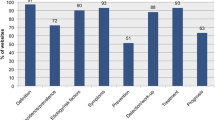Abstract
Purpose
Prophylactic surgery decisions are difficult. Supplemental information improves patients’ knowledge, promoting active participation in decision-making. Our objective was to examine internet information regarding prophylactic surgery for familial adenomatous polyposis to determine its adequacy in facilitating patient participation in surgical decision-making.
Methods
We searched the internet for information on surgery for familial adenomatous polyposis, using an intentionally simple strategy to represent patients’ searches. We examined the first 50 sites from each search, assessing each for content by using predefined criteria. Every site was evaluated by two investigators (kappa 0.71) by using the DISCERN criteria, a tool for evaluating quality of health information. Search-efficiency was calculated.
Results
Searches revealed 307,138 “hits”; 20 sites met inclusion criteria. GOOGLE™ demonstrated the highest search-efficiency (28 percent). Sites were maintained by general health pages (35 percent), hospitals (30 percent), professional organizations (15 percent), familial adenomatous polyposis registries (10 percent), and government (10 percent). Only 40 percent had been developed and/or updated within two years. Most included basic information regarding risk, symptoms, diagnosis, as well as discussion of familial adenomatous polyposis-associated diseases and surveillance (80–100 percent). Although 90 percent of sites presented surgical treatment options, only 60 percent provided details. Few provided information regarding postoperative bowel function (40 percent), sexual function (20 percent), or fertility (5 percent). Seven (35 percent) were identified as being of “good/excellent” quality. Only four were patient-oriented; variable information was provided.
Conclusions
Internet information regarding surgical treatment of familial adenomatous polyposis is sparse, and insufficient to support active patient participation in decision-making. Despite the time and financial commitment required, development of high-quality internet resources may be justified given the lack of adequate patient-oriented information currently available.



Similar content being viewed by others
References
Guillem JG, Wood WC, Moley JF, et al. ASCO/SSO review of current role of risk-reducing surgery in common hereditary cancer syndromes. J Clin Oncol 2006;24:4642–60.
Davey HM, Butow PN, Armstrong BK. Cancer patients’ preferences for written prognostic information provided outside the clinical context. Br J Cancer 2003;89:1450–6.
Whelan T, Levine M, Willan A, et al. Effect of a decision aid on knowledge and treatment decision making for breast cancer surgery: a randomized trial. JAMA 2004;292:435–41.
Davison BJ, Degner LF. Empowerment of men newly diagnosed with prostate cancer. Cancer Nurs 1997;20:187–96.
Butow P, Brindle E, McConnell D, Boakes R, Tattersall M. Information booklets about cancer: factors influencing patient satisfaction and utilization. Patient Educ Couns 1998;33:129–41
Fox S. Online Health Search 2006. Washington, DC: Pew Internet and American Life Project. Available at: http://www.pewinternet.org/pdfs/PIP_Online_Health_2006.pdf, Vol. 2006. Accessed November 7, 2006
Macklin C. Colorectal website review: hemorrhoids. Dis Colon Rectum 2006;49:1646–7.
Eysenbach G, Kohler C. How do consumers search for and appraise health information on the world wide web? Qualitative study using focus groups, usability tests, and in-depth interviews. BMJ 2002;324:573–7
Hansen DL, Derry HA, Resnick PJ, Richardson CR. Adolescents searching for health information on the Internet: an observational study. J Med Internet Res 2003;5:e25.
Charnock D, Shepperd S, Needham G, Gann R. DISCERN: an instrument for judging the quality of written consumer health information on treatment choices. J Epidemiol Community Health 1999;53:105–11.
Chen X, Siu LL. Impact of the media and the internet on oncology: survey of cancer patients and oncologists in Canada. J Clin Oncol 2001;19:4291–7.
Jenkins V, Fallowfield L, Saul J. Information needs of patients with cancer: results from a large study in UK cancer centres. Br J Cancer 2001;84:48–51.
Berland GK, Elliott MN, Morales LS, et al. Health information on the Internet: accessibility, quality, and readability in English and Spanish. JAMA 2001;285:2612–21
Eysenbach G, Powell J, Kuss O, Sa ER. Empirical studies assessing the quality of health information for consumers on the world wide web: a systematic review. JAMA 2002;287:2691–700.
Ekman A, Hall P, Litton JE. Can we trust cancer information on the Internet? A comparison of interactive cancer risk sites. Cancer Causes Control 2005;16:765–72.
Ilic D, Risbridger G, Green S. Searching the Internet for information on prostate cancer screening: an assessment of quality. Urology 2004;64:112–6.
Al-Bahrani A, Plusa S. The quality of patient-orientated internet information on colorectal cancer. Colorectal Dis 2004;6:323–6.
Sacchetti P, Zvara P, Plante MK. The Internet and patient education–resources and their reliability: focus on a select urologic topic. Urology 1999;53:1117–20.
Meric F, Bernstam EV, Mirza NQ, et al. Breast cancer on the world wide web: cross sectional survey of quality of information and popularity of websites. BMJ 2002;324:577–81.
Jadad AR, Gagliardi A. Rating health information on the Internet: navigating to knowledge or to Babel? JAMA 1998;279:611–4.
Ley P, Bradshaw PW, Eaves D, Walker CM. A method for increasing patients’ recall of information presented by doctors. Psychol Med 1973;3:217–20.
Author information
Authors and Affiliations
Corresponding author
Additional information
Dr. Neuman is a research fellow of the Agency for Healthcare Quality and Research; this project was partially supported by grant number 5 T32 HS000066-13. Dr. Temple is supported in this project by a Career Development Award from the American Society of Clinical Oncology.
Reprints are not available.
About this article
Cite this article
Neuman, H.B., Cabral, C., Charlson, M.E. et al. Is Internet Information Adequate to Facilitate Surgical Decision-Making in Familial Adenomatous Polyposis?. Dis Colon Rectum 50, 2135–2141 (2007). https://doi.org/10.1007/s10350-007-9036-z
Received:
Accepted:
Published:
Issue Date:
DOI: https://doi.org/10.1007/s10350-007-9036-z




